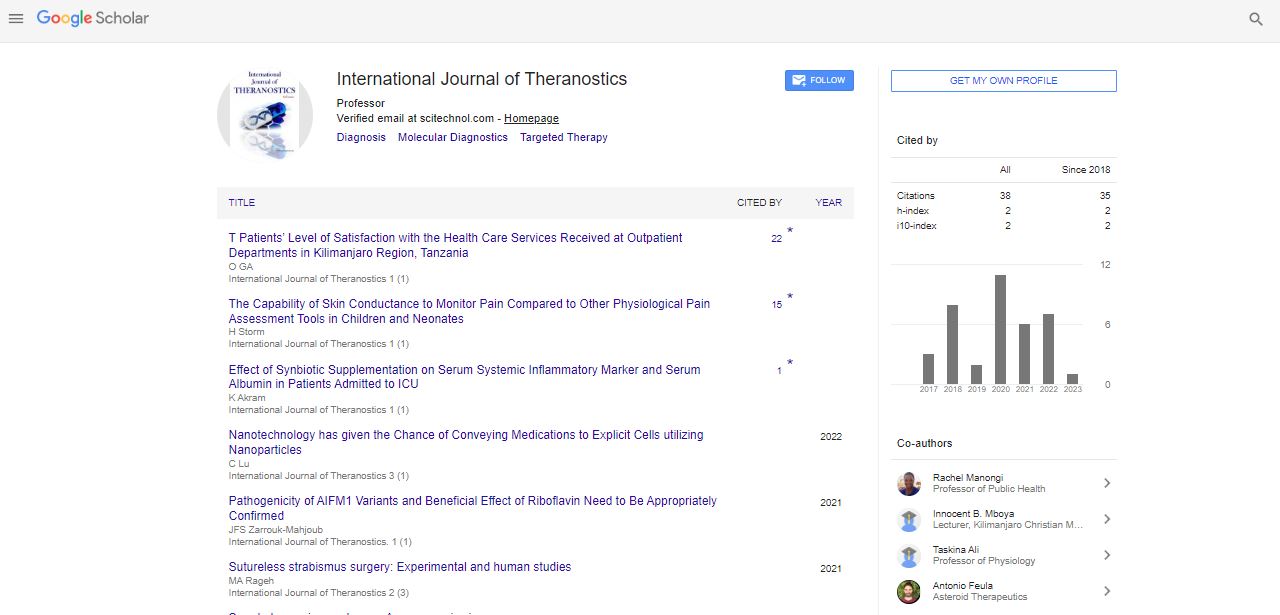Opinion Article, Ijt Vol: 12 Issue: 3
Significance of Gallium Isotopes and the Future of Medical Imaging
Tomas Winkpeny*
1Department of Surgical Sciences, Uppsala University, Uppsala, Sweden
*Corresponding Author: Tomas Winkpeny,
Department of Surgical Sciences,
Uppsala University, Uppsala, Sweden
E-mail: toms.peny88@surgsci.uu.se
Received date: 30 August, 2023, Manuscript No. IJT-23-117613;
Editor assigned date: 01 September, 2023, PreQC No. IJT-23-117613 (PQ);
Reviewed date: 15 September, 2023, QC No. IJT-23-117613;
Revised date: 22 September, 2023, Manuscript No. IJT-23-117613 (R);
Published date: 02 October, 2023, DOI: 10.4172/IJT.1000137.
Citation: Winkpeny T (2023) Significance of Gallium Isotopes and the Future of Medical Imaging. Int J Theranostic 12:3.
Abstract
Medical imaging has undergone remarkable advancements over the years, providing invaluable insights into the human body's inner workings. Gallium radioisotopes, specifically Gallium-67 and Gallium-68, have emerged as critical tools in the field of nuclear medicine. These isotopes offer the ability to detect and visualize a wide range of diseases, making them indispensable in diagnostic and therapeutic applications.
Description
Medical imaging has undergone remarkable advancements over the years, providing invaluable insights into the human body's inner workings. Gallium radioisotopes, specifically Gallium-67 and Gallium-68, have emerged as critical tools in the field of nuclear medicine. These isotopes offer the ability to detect and visualize a wide range of diseases, making them indispensable in diagnostic and therapeutic applications. In this article, we will explore the significance and applications of Gallium radioisotopes in medical imaging.
Application of gallium-67 in diagnosis
Gallium-67 (Ga-67) is a radioisotope with a half-life of approximately 78 hours, emitting gamma radiation. It has been used in nuclear medicine since the 1960s and is primarily employed for diagnostic purposes. Ga-67 is used in a technique known as Gallium-67 scintigraphy, which is used to visualize and evaluate various pathological conditions within the human body. Ga-67 scintigraphy is highly effective in detecting infections and inflammations. In particular, it has proven invaluable in diagnosing conditions like osteomyelitis, which can be challenging to diagnose through other imaging techniques. Ga-67 is also used to locate and assess tumors. In cases where other imaging modalities, like CT scans or MRIs, fail to provide sufficient information about the extent or activity of a tumor, Ga-67 scintigraphy can be a valuable complementary tool. Ga-67 scintigraphy plays a crucial role in staging and assessing the response to treatment in patients with lymphomas. Sarcoidosis, a multisystem inflammatory disease, is another condition where Ga-67 scintigraphy is particularly useful. It helps in identifying and monitoring the progression of granulomas within affected organs.
Application of gallium-68 in nuclear medicine
Gallium-68 (Ga-68) is another gallium radioisotope that is gaining prominence in medical imaging. Ga-68 has a shorter half-life of approximately 68 minutes and emits positrons, making it suitable for Positron Emission Tomography (PET) imaging. One of the most exciting developments in nuclear medicine is the role of Ga-68 in theranostics, a field that combines diagnostic and therapeutic approaches for personalized medicine. Ga-68 PET imaging offers exceptional resolution and sensitivity. It is used for detecting and staging various cancers, including prostate, neuroendocrine, and breast cancers. Ga-68 PSMA PET (Prostate-Specific Membrane Antigen) scans, for example, have revolutionized the management of prostate cancer by precisely identifying metastases. Ga-68-DOTATOC and Ga-68-DOTATATE PET scans are used to identify and assess neuroendocrine tumors, particularly in the brain and spine. Ga-68 can be paired with therapeutic isotopes to deliver targeted radiation therapy. This approach, known as theranostics, offers precise treatment options for patients with specific cancer types, such as neuroendocrine tumors.
The future of gallium radioisotopes
The applications of Gallium radioisotopes continue to expand, with ongoing research and development exploring new possibilities. With the rise of theranostics, Ga-68 holds promise for tailored cancer treatments, where the same isotope used for diagnosis can also be employed for therapy. Additionally, efforts are underway to improve the availability and cost-effectiveness of Ga-68 production to make these advanced imaging techniques more accessible to patients. While Gallium radioisotopes offer remarkable benefits, they also present challenges. Ga-67 has a relatively long half-life, which may require patients to return for delayed imaging, and its applications are mainly diagnostic. Ga-68, with its short half-life, requires a cyclotron nearby for production, limiting its widespread availability. Moreover, radiopharmaceuticals containing Gallium radioisotopes should be handled with care, as they involve ionizing radiation. Radioprotection measures are essential to ensure the safety of patients and healthcare workers.
Conclusion
Gallium radioisotopes have become indispensable tools in the field of medical imaging and nuclear medicine. Gallium-67 serves as a powerful diagnostic agent for various diseases, including infections, tumors, and inflammatory conditions. Gallium-68, on the other hand, is at the forefront of the theranostics revolution, allowing for personalized cancer diagnosis and treatment. As technology and research continue to evolve, the applications of Gallium radioisotopes will likely expand, further improving our ability to diagnose and treat diseases with precision. These isotopes represent a shining example of the synergy between diagnostic and therapeutic approaches, leading to more effective and personalized patient care in the realm of medical imaging.
 Spanish
Spanish  Chinese
Chinese  Russian
Russian  German
German  French
French  Japanese
Japanese  Portuguese
Portuguese  Hindi
Hindi 